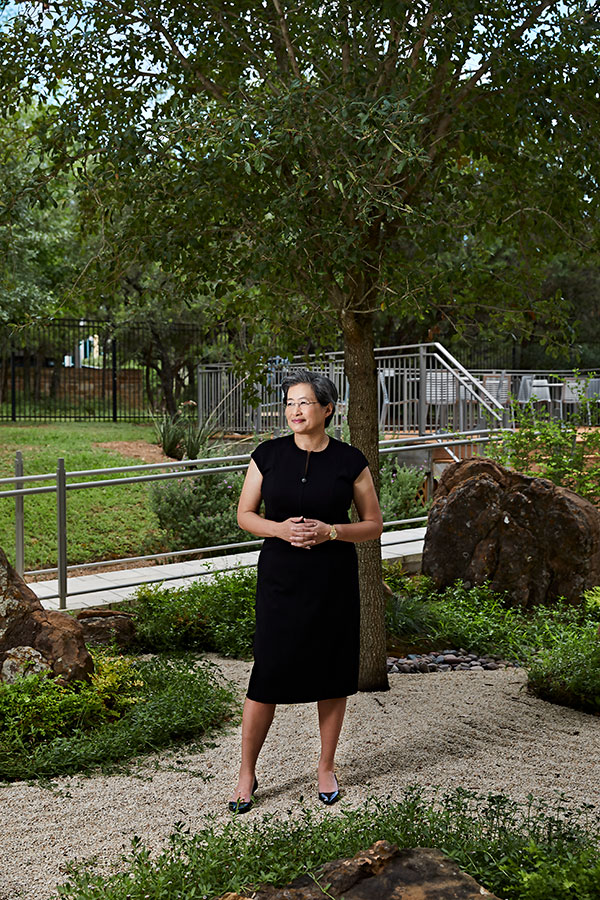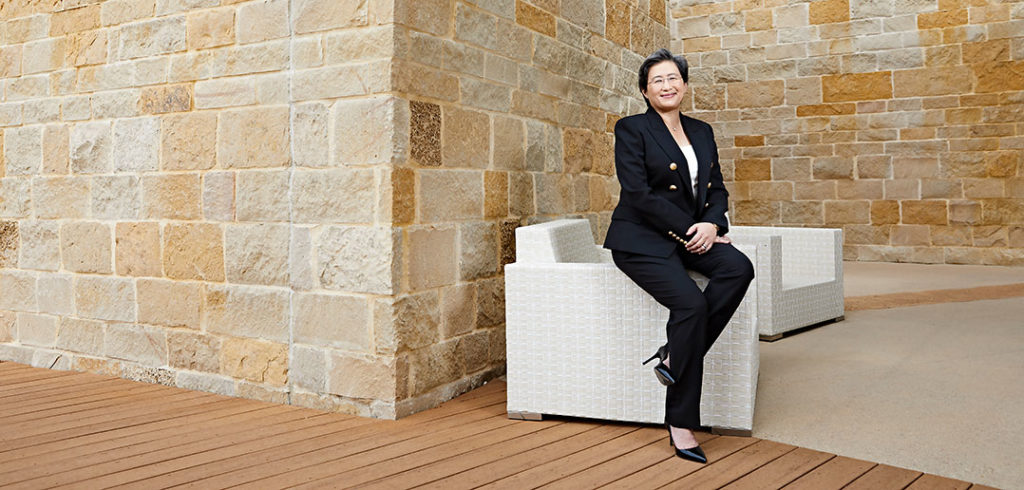As the first woman CEO of a semiconductor company, the problem solver – Lisa Su is taking the tech industry by storm.
By Jenny Hoff, Photos by Annie Ray, Shot on location at AMD
When chatting with Lisa Su, it’s easy to forget you’re talking to one of the most influential, highly paid Fortune 500 CEOs in the country. With a quiet confidence and humility, she credits her parents—who emigrated from Taiwan to America when she was 2 years old—for much of her success. Their sacrifice, example and commitment to excellence have driven her achievements even from a young age.
“You could say I had a typical Asian upbringing. The way I grew up was you study hard, you work hard and you always have to strive to be the best. My big failure to them was I went to Chinese school as a kid and my Chinese handwriting was horrible,” she laughs. “I always got a C in handwriting and it drove them crazy.”
While Chinese handwriting might not have been her forte, fixing things was. Growing up in Queens, New York, she spent her time as a child taking apart her brother’s broken remote-control cars and repairing them. That curiosity and determination to fix an issue helped pave her way as an engineer and leader. Where most people tried to avoid problems, Su sought them out.
“I was given a piece of advice when I was a young engineer at IBM that has really stuck with me. Someone told me, ‘You should run toward problems,’” she recalls. “If you’re going to work on something, work on something that’s really important.”
In 2012, that mentality led her to say yes to a job with a very uncertain future at Austin-based Advanced Micro Devices. Recruited by Nick Donofrio, her former mentor, the former executive vice president of technology and innovation at IBM and an AMD board member, Su left a leadership position at Freescale to take on the roles of senior vice president and general manager of Global Business Units at AMD. It was a risky career move with the company’s stock at an all-time low and its long-term viability on the line.
“I told her it was going to be miserable,” Donofrio recalls. “…We were wallowing in our own self-pity.” But Lisa can tolerate uncertainty. She understands that nothing exists; everything has to be made to exist. She understands that down to the silica. Circuits don’t just fall out of your pockets; you need to bring them into existence.”
Su took the job and then took over as president and CEO 2 1/2 years later. Today, the company’s stock is worth more than $69 a share—a comeback story almost unheard of in this highly competitive industry.
“She’s the Joan of Arc,” Donofrio says. “She did it. She plowed new territory and set the new standard.”
Donofrio’s admiration for Su isn’t just due to her ability to lead, listen and make strategic decisions but for her desire to help more women follow her path. While tech is still a male-dominated sector, when Su started out more than 20 years ago, there were virtually no female leaders at all and certainly no clear path to the top. After spending 15 years building a stellar reputation at IBM, she eventually left for Freescale where she gained more opportunities to lead big teams, which in turn prepared her for her current role at AMD.
Su is hesitant to speak of herself as an icon in the industry, preferring to let her work speak for itself. That could be due to her upbringing, where success was more of a duty than a reward and she was taught great achievement comes only with great effort. At the urging of her parents, she started playing piano competitively at 7 years old, practicing hours a day in addition to later taking public transportation a total of four hours a day to go to and from one of the most competitive public magnet high schools in the country, The Bronx High School of Science.
When she decided to go to MIT, arguably the best engineering school in the world, her parents were almost as disappointed as when she brought home a C in Chinese handwriting.
“I think my mother would have preferred I become a pianist instead of an engineer,” she says, laughing. “But I didn’t get into Juilliard. I got into MIT.”
In today’s parenting culture, this might seem like extreme pressure for a child but it’s obvious Su respects and loves her parents precisely for pushing her to realize her full potential. And they never expected anything from her that they didn’t expect from themselves.
“My mom’s been a large inspiration in my life,” Su says. “Along the way, even without speaking perfect English, she runs an import and export business where she connects manufacturers in Taiwan with trucking businesses. She built up a multi-million-dollar enterprise. And she is always there for me.”
Relationships are the cornerstone to Su’s leadership philosophy. Part of her strategy in helping turn AMD around was building strong relationships with clients through honesty, trust and transparency. She did the same with her more than 10,000 employees.

“She is showing that technology wins and good partnerships win,” says Laura Smith, graphics chief engineer for AMD. “She is all about competing with people at their best: open standards and an open development environment. She has the confidence that we on our team can compete with the best and beat them on their best day. When someone believes in you like that, you stand up stronger. She has shown the industry that that recipe can work.”
Smith says the reassurance of working under such strong and caring leadership has given their team of engineers the confidence to create products that have helped AMD reach its success today. Under Su’s leadership, AMD expanded into the graphics and video games chip market, becoming the chip provider for both Microsoft’s Xbox and Sony’s PlayStation gaming consoles.
These strategic moves and the now soaring AMD stock has made Su one of the most celebrated CEOs in the country and earned her a slew of awards and accolades. Barron’s dubbed her one of the World’s Best CEOs of 2019 and she was included on Harvard Business Review’s 2019 list of best performing CEOs in the world, the National Diversity Council’s 2017 list of the 50 most powerful women in technology and Fortune’s 2017 World’s Greatest Leaders. In 2019, she was the first woman to ever top the Associated Press’ annual CEO compensation list.
Smith says it’s almost incredible how, despite how high-profile Su has become, she still takes the time to mentor other women in the field.
“I had her help me through what was a crisis situation for me,” Smith says. “She has always told me in our mentoring relationship to reach out to her anytime. I had a customer meeting that went sideways, and I couldn’t sleep all night. I sent her an email that said, ‘Whenever you have a minute, I would like to get on your calendar so we can talk about this.’ She called me a few minutes later. It was 5:30 in the morning. It wasn’t a crisis for her or the company, but she still took the time to help lead me through it.”
Su believes relationships are for a lifetime, whether it be clients, colleagues, friends or family. And she’s a problem solver, which means she’s driven to fix problems the people in her life may be facing. Despite the fact she runs a company worth $66 billion (it was worth $2 billion when she took over as CEO), carries the mantle of being the only woman CEO of a semiconductor company and travels the world almost constantly, she didn’t hesitate to pack up and stay at a New York hospital virtually round the clock for three months when her mother fell gravely ill last year.
“Luckily, we were able to manage through this,” says Su, pausing with emotion as she recalls those months. “It was an eye-opener for me. I had a great team and I would be sitting at the hospital doing conference calls. It was one of those times when you realize there are things that are more important. No one is going to advocate for your family better than you are. It doesn’t matter who you are; you have to be sitting there when the doctor walks in.” Su has decided if she gets a next life, she’ll spend it modernizing health care.
But for now, it’s her own company—and industry—she’s heralding into the future.
AMD at a Glance
Founded: 1969 in Silicon Valley
Number of employees: 12,015
Percentage of woman employees: 24 percent
Main product: semiconductor devices used in computer processing

Austin Woman: What are three pieces of advice you would give a woman forging her own career path?
Lisa Su: “One, a good, strong education is very important.
Nobody can take your education away from you; it’s your
calling card. Two, be ambitious in what you do. I think a lot
of women are afraid to think big but I would say be ambitious. And, three, take feedback to heart and learn from your failures. I really believe that’s what makes you better.”
AW: How do you gain the confidence to lead or aim for leadership positions?
LS: “I absolutely think leaders are trained, not born. I’m a product of that. I believe a huge part of success is when leaders are given training opportunities and do career planning. You can learn a lot if you’re in the right environment. What I noticed when I came here is we had a lot of good people but weren’t systematic in how we made them better. I want to invest in
their success and give them training.”
AW: How can women rise to the top in an industry that is mostly made up of men?
LS: “What I would like women to understand is in engineering either the product works or doesn’t work. You absolutely can be successful if you’re smart, ambitious and make some good choices. It’s not as intimidating as it may seem. As you see more women in engineering and tech, more will join us. Our team is about 25-percent women. We have a women’s network to help grow leadership. We have highly visible women engineers.
I happen to mentor most of them.”
AW: You mentioned this is a 24-hour-a-day job. What do you and your husband like to do in your rare free time here in Austin?
LS: “We like the restaurant scene here. We especially like Lin’s Chinese Restaurant downtown. And we like to play golf at Barton Creek Country Club.”
AW: I know your parents initially wanted you to be a pianist. Are they proud of you now?
LS: “They’re proud. In the Taiwanese community, they follow AMD a lot. I don’t ever talk to my parents about AMD, but they seem to know everything about it.”




